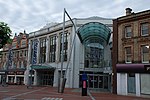Bridge Street, Reading
Bridges in Reading, BerkshireEngvarB from September 2013History of Reading, BerkshireKennet and Avon CanalStreets in Reading, Berkshire

Bridge Street, formerly known as Seven Bridges, is a historic street in the town of Reading in the English county of Berkshire. It took its original name from the seven bridges that carried it over various channels of the River Kennet, and was the earliest crossing place of that river in the town.Bridge Street connects Southampton Street, formerly known as St Giles' Street, to the south, with St Mary's Butts to the north.
Excerpt from the Wikipedia article Bridge Street, Reading (License: CC BY-SA 3.0, Authors, Images).Bridge Street, Reading
Bridge Street, Reading Coley
Geographical coordinates (GPS) Address Nearby Places Show on map
Geographical coordinates (GPS)
| Latitude | Longitude |
|---|---|
| N 51.452483333333 ° | E -0.97238611111111 ° |
Address
Bridge Street
Bridge Street
RG1 6BH Reading, Coley
England, United Kingdom
Open on Google Maps









